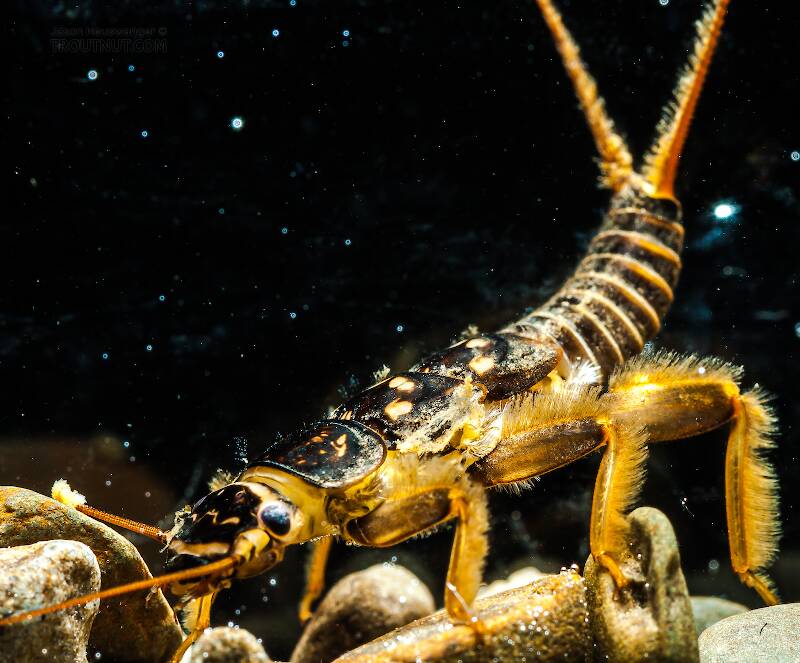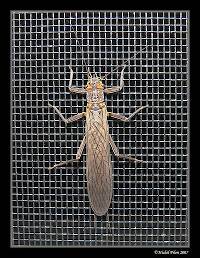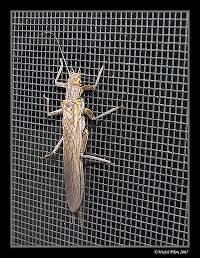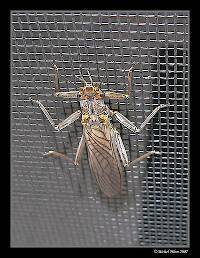
Hex Mayflies
Hexagenia limbata
The famous nocturnal Hex hatch of the Midwest (and a few other lucky locations) stirs to the surface mythically large brown trout that only touch streamers for the rest of the year.
Featured on the forum

I caught this tiny larva without a case, but it seems to key pretty clearly to to Glossosomatidae. From there, the lack of sclerites on the mesonotum points to either Glossosoma or Anagapetus. Although it's difficult to see in a 2D image from the microscope, it's pretty clear in the live 3D view that the pronotum is only excised about 1/3 of its length to accommodate the forecoxa, not 2/3, which points to Glossosoma at Couplet 5 of the Key to Genera of Glossosomatidae Larvae.

Troutnut is a project started in 2003 by salmonid ecologist Jason "Troutnut" Neuswanger to help anglers and
fly tyers unabashedly embrace the entomological side of the sport. Learn more about Troutnut or
support the project for an enhanced experience here.
Troutnut on May 18, 2007May 18th, 2007, 8:02 am EDT
I'm pretty sure this is Paragnetina. Can anyone who knows that genus well fill in the species?
Jason Neuswanger, Ph.D.
Troutnut and salmonid ecologist
Troutnut and salmonid ecologist
GONZO on May 19, 2007May 19th, 2007, 9:07 am EDT
Jason,
As far as I know, the only species of Paragnetina we have in NY and PA are media and immarginata. The latter, the "beautiful stone," is highly patterned in yellow/black/brown and has very distinctive markings. The markings on this specimen seem somewhat unusual for media. Were it not for what appears to be a complete setal row across the occiput, I'd be inclined toward Acroneuria.
As far as I know, the only species of Paragnetina we have in NY and PA are media and immarginata. The latter, the "beautiful stone," is highly patterned in yellow/black/brown and has very distinctive markings. The markings on this specimen seem somewhat unusual for media. Were it not for what appears to be a complete setal row across the occiput, I'd be inclined toward Acroneuria.
Mlajoie
Posts: 6
Posts: 6
Mlajoie on Mar 18, 2008March 18th, 2008, 5:45 am EDT
Guys,
I have noticed that several of the pictures on this website are mis-identified. This set of photos is not of Paragnetina at all. There is clearly no occipital ridge. It is true that the only species of Paragnetina found in the State of NY are immarginata and media, but this specimine is clearly Acroneuria sp.
I am also from NY and I am a NABS certified taxonomist. My company offers macroinvertebrate taxonomy workshops for professionals. If anyone is interested in improving their ID skills, have a look at the "Upcoming Workshops" tab of our website. Also, feel free to contact me directly and I'd be happy to point you in the direction of some useful dichotomous keys.
Web: www.rwaa.us
emaial: mlajoie@rwaa.us
-Matt Lajoie
Aquatic Biologist and Taxonomist
Watershed Assessment Associates, LLC
I have noticed that several of the pictures on this website are mis-identified. This set of photos is not of Paragnetina at all. There is clearly no occipital ridge. It is true that the only species of Paragnetina found in the State of NY are immarginata and media, but this specimine is clearly Acroneuria sp.
I am also from NY and I am a NABS certified taxonomist. My company offers macroinvertebrate taxonomy workshops for professionals. If anyone is interested in improving their ID skills, have a look at the "Upcoming Workshops" tab of our website. Also, feel free to contact me directly and I'd be happy to point you in the direction of some useful dichotomous keys.
Web: www.rwaa.us
emaial: mlajoie@rwaa.us
-Matt Lajoie
Aquatic Biologist and Taxonomist
Watershed Assessment Associates, LLC
Troutnut on Mar 18, 2008March 18th, 2008, 6:08 am EDT
Thanks Matt. Please post correct IDs on any specimens you find misidentified, if you've got time. That's why I built the forum into the main site the way I did, so experts can weigh in on such tricky business.
Jason Neuswanger, Ph.D.
Troutnut and salmonid ecologist
Troutnut and salmonid ecologist
Entoman on Mar 11, 2012March 11th, 2012, 4:53 am EDT
This is most likely an A. abnormis nymph. The other likely possibilities, A. carolinensis and lycorias are marked differently in several ways that seem to hold up most of the time.
Femora - abnormis has dark longitudinal streaks; carolinensis and lycorias usually have pale bands or blotches.
Pale occiput band - abnormis is usually more uniform in width (and usually thinner) with thin detached commas around the lateral ocelli or absent; carolinensis tapers progressively wider towards the margins with a pair of thick connected dashes adjacent to the ocelli. lycorias usually has a large dark spot intruding into the occipital band in the center making it appear very thin in that location.
"W" mark - abnormis is thin & often broken; both carolinensis and lycorias are usually bold.
Dorsal habitus - generally, abnormis is darker overall and doesn't usually have the contrasting abdominal banding often obvious on the other two.
A. lycorias can be easy to confuse with carolinensis as their markings can be very similar in the nymphal stage. Fortunately, lycorias usually has obvious anal gills lacking in the others.
Femora - abnormis has dark longitudinal streaks; carolinensis and lycorias usually have pale bands or blotches.
Pale occiput band - abnormis is usually more uniform in width (and usually thinner) with thin detached commas around the lateral ocelli or absent; carolinensis tapers progressively wider towards the margins with a pair of thick connected dashes adjacent to the ocelli. lycorias usually has a large dark spot intruding into the occipital band in the center making it appear very thin in that location.
"W" mark - abnormis is thin & often broken; both carolinensis and lycorias are usually bold.
Dorsal habitus - generally, abnormis is darker overall and doesn't usually have the contrasting abdominal banding often obvious on the other two.
A. lycorias can be easy to confuse with carolinensis as their markings can be very similar in the nymphal stage. Fortunately, lycorias usually has obvious anal gills lacking in the others.
"It's not that I find fishing so important, it's just that I find all other endeavors of Man equally unimportant... And not nearly as much fun!" Robert Traver, Anatomy of a Fisherman
Quick Reply
Related Discussions
Topic
Replies
Last Reply
Acroneuria specimen moved from genus to species level
In Acroneuria carolinensis Stonefly Nymph by Entoman
In Acroneuria carolinensis Stonefly Nymph by Entoman
0
Mar 11, 2012
by Entoman
by Entoman
1
Oct 28, 2008
by GONZO
by GONZO
6
Mar 19, 2012
by Entoman
by Entoman
Re: Helopicus subvarians (Stonefly) common in New York waters!
In the Stonefly Genus Helopicus by Walleye
In the Stonefly Genus Helopicus by Walleye
6
Jan 9, 2014
by Entoman
by Entoman
56
Aug 23, 2013
by Trout_House
by Trout_House
2
Jan 19, 2010
by Dkak
by Dkak







